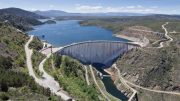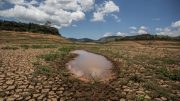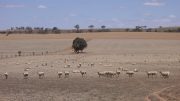Drought conditions are becoming more common across the West, and Wyoming lawmakers are looking at some ideas for how to conserve and replenish water resources. Last year, lawmakers failed to fully fund an $80 million dam project on the Wyoming-Colorado border, instead, giving about $5 million to try to persuade Colorado to join forces since ranchers there could benefit, too.
The Wyoming Water Development Office recently made a presentation and gave tours of possible dam sites to a Colorado water conservation board. Director Harry LaBonde said afterward, Colorado officials signed a letter in support of the West Fork dam idea but didn’t make any funding commitments. He said there’s another factor impeding the dam’s progress.
“Colorado has a new governor coming on board, as does Wyoming,” he said. “And so I think it’s a resetting of the clock in regards to those ultimate decision makers.”
LaBonde said he has more hope for a bill to pay for expansion costs on the Big Sandy Reservoir in western Wyoming.
“We will add a five-foot enlargement on this, and it will then provide [Eden Valley irrigators] with additional water supply for those existing lands,” LaBonde said.
Like the West Fork dam project, the Big Sandy expansion would capture more of Wyoming’s share of water flowing into the Colorado River system. That’s in hopes of stockpiling water as droughts caused by climate change continue to hurt Wyoming ranchers.
A bill going before the Wyoming legislature hopes to provide relief for that problem too, seeking approval for a cloud seeding project over two mountain ranges on the Wyoming-Colorado border. The state already conducts similar weather modification in the Wind River Range, but the hope is to increase the amount of snowpack in the Medicine Bow and Sierra Madre Ranges that drain into the North Platte River system.
LaBonde said the way cloud seeding works is by increasing the number of particles inside clouds so they form more snowflakes.
“Silver iodide is the medium is we’re using,” he said. “So those molecules or particles are dispersed into the clouds and they allow that water vapor to attach and then condense. And therefore, you increase the amount of precipitation over the clouds that are moving over a mountain range.”
LaBonde said the weather modification project would be a collaboration with the water conservation district in Jackson County, Colorado.
JAN 9, 2019
Originally published by Wyoming Public Media





